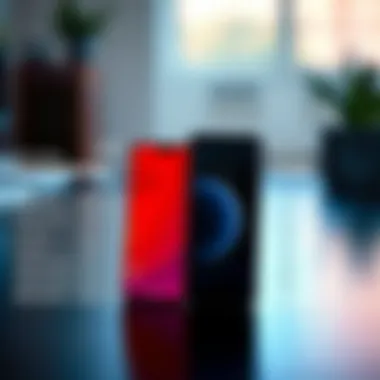Best Affordable Smartphones Under $150 for 2023


Overview
In a world where technology is ever-evolving, the smartphone market has seen a remarkable shift towards affordability without compromising on essential features. Given the ongoing advancements and fierce competition among manufacturers, consumers are now faced with an expanding array of options priced below $150. This article aims to shed light on these budget-friendly smartphones, pinpointing their benefits, drawbacks, and user experiences.
Understanding the significance of this topic requires recognition of the growing demand for cost-effective devices. Many individuals are in search of reliable smartphones that cater to day-to-day needs without breaking the bank. For instance, people in developing regions often rely on affordable smartphones for connectivity and access to information. In developed areas, budget-conscious users including students and young professionals are equally appreciative of these devices for their basic functionalities.
By exploring the marketplace, dissecting specific features, and evaluating performance metrics, this article offers a straightforward guide for consumers. Whether you’re a tech enthusiast or simply looking for value in a smartphone purchase, this examination of options under $150 will empower you to make informed choices.
Features & Specifications
When diving into the specifics of smartphones in this price bracket, it's vital to note the standout features that typically define them:
- Display: Most affordable smartphones come equipped with HD displays, measuring between 5.5 to 6.5 inches—adequate for streaming videos or browsing the web.
- Processor: While often not top-tier, processors like MediaTek or Qualcomm’s Snapdragon 400 series provide reasonable performance for everyday tasks.
- Memory and Storage: Expect 2GB to 4GB of RAM and storage options ranging from 16GB to 64GB. Many models allow for microSD expansion.
- Camera Quality: Dual camera setups are becoming more common in this price range, with primary sensors around 13MP, suitable for casual photography.
- Battery Life: Batteries usually span between 3000 to 5000 mAh, ensuring a full day of moderate usage.
These specifications mean that, although these phones are budget-friendly, they still offer essential features for most users.
Pros and Cons
When weighing the options, it's prudent to be aware of both advantages and potential drawbacks of smartphones under $150:
Pros
- Affordability: The primary strength—getting solid basic features without spending a fortune.
- Functionality: Sufficient for common tasks like messaging, social media, and browsing.
- Growing Options: The variety available means users can select based on specific preferences like brand loyalty or design.
Cons
- Performance Limits: Heavy gaming and multitasking may lead to slowdowns.
- Build Quality: While some models do boast decent materials, they may not feel as premium as their pricier counterparts.
- Software Support: Updates might be infrequent compared to flagship models, potentially leading to delays in improved features or security patches.
User Experience
Real-world insights can often reveal as much as technical specifications. Feedback from users across various forums and review sites provides a glimpse into their satisfaction and experiences:
"I was surprised how well my new phone performs for the price. I can run apps, watch videos, and even take decent pictures!" - a user from Reddit.
Many users express contentment with their decision, particularly valuing the balance of price and performance. However, some do mention they wish for enhanced battery life or better camera quality.
Buying Guide
When considering a purchase in this category, keep in mind the following recommendations:
- Assess Your Needs: Identify your primary usage. If you need a phone mainly for texting and calling, a basic model suffices. If photography is your passion, look for one with a better camera.
- Read Reviews: Platforms such as Reddit or tech blogs can provide insights into user experiences, rating the performance based on real-world application.
- Compare Models: Don’t settle for the first model you see. Check various options, looking for sales or discounts.
- Check for Updates: Ensure the device is capable of software updates to maintain security and usability.
With this guide, navigating the choices of smartphones priced under $150 becomes a simpler task, allowing you to make a decision that fits both your lifestyle and budget.
For more information on smartphone choices, visit Wikipedia or check out discussions on Reddit for user feedback.
Prologue to Affordable Smartphones
In a world where tech advances at breakneck speed, the importance of affordable smartphones cannot be overstated. With prices often climbing above 700 or even 1000 dollars, many consumers find themselves pricing out of the market for a decent device. This article focuses on smartphones priced under 150 dollars, highlighting these budget-friendly gadgets that often pack a punch despite their low cost.
For many people, especially first-time buyers or those in developing regions, these affordable devices are not just a luxury; they are a necessity. They offer connectivity, access to information, and a means of communication that can empower everyday life. The importance lies in understanding how to make informed choices without breaking the bank.
Understanding the Market Trends
The smartphone market has experienced significant shifts in recent years. More brands are stepping into the budget segment, intensifying competition. Companies like Xiaomi, Realme, and Motorola have flooded the market with options that are more accessible than ever. According to recent analysis, there’s a clear trend of rising quality within these budget devices. A few years back, consumers might have expected to compromise heavily on features, but that's changing.
Key trends:
- Increased Competition: As more players enter the budget smartphone scene, consumers stand to benefit from constant innovations and improved features.
- Focus on User Experience: Brands are increasingly investing in the user interface and experience, making these phones not just functional, but enjoyable.
- Durability and Design: Modern affordable smartphones boast sturdier designs that can withstand daily wear and tear, catering to the practical needs of most users.


Consumer Expectations and Needs
Consumers are savvy these days and know exactly what to expect when it comes to budget smartphones. The reality is many want a device that delivers on key functionalities without the hefty price tag. Most users aren't looking for a gaming powerhouse, but rather a reliable phone to handle daily tasks.
Some common expectations include:
- Good Battery Life: Users expect a phone that can last through their busy schedules without requiring frequent charges.
- Decent Camera Quality: In a world driven by social media, having a camera that performs well in various conditions is crucial.
- Smooth Performance: While price is a factor, a lag-free experience is still a must-have.
In essence, understanding the landscape of affordable smartphones provides valuable insights into why this sector continues to thrive amid changing technology. Grasping consumer expectations and recognizing market trends play pivotal roles in making informed decisions.
Key Features of Smartphones Under
When diving into the realm of budget smartphones, particularly those priced under 150, it’s crucial to understand the key features that define their usability and appeal. While these devices might not boast the high-end specifications found in flagship models, they deliver essential functionalities that meet the everyday needs of consumers. This section unpacks various elements that contribute to the value of these smartphones, spotlighting their advantages and any considerations to keep in mind.
Display Quality and Size
The display is one of the first things users notice. A smartphone's screen quality can make or break the user experience. In this price range, displays can vary widely; however, many models offer respectable HD resolution or even Full HD options that bring visuals to life. Some potential buyers might lean towards larger screens, enjoying the expansive real estate for streaming videos or browsing social media. On the flip side, a smaller size may be preferable for those who value portability. Keep in mind that while some devices come with a decent pixel density, viewing angles and brightness may sometimes take a hit. That said, many users find that well-optimized software can alleviate some of these display shortcomings, rendering content vividly enough for day-to-day tasks.
Camera Capabilities
For many, the camera is a standout feature on a smartphone. In the under 150 category, you'll generally find devices equipped with multiple lenses, including wide-angle and macro capabilities. However, the actual performance can vary considerably.
- Look for specifications like megapixel count, aperture size, and image stabilization features.
- While the likes of Xiaomi Redmi 9A or Samsung Galaxy A11 may not compare to more expensive models, they often surprise users with acceptable photos under good lighting conditions.
- Remember, night photography can be a mixed bag, often resulting in grainy images. Ultimately, if the goal is social media snapshots, most of these cameras will do just fine.
Battery Life Considerations
When evaluating budget smartphones, battery life is paramount. After all, what good is a smartphone if it can’t keep up with your daily grind? Many phones in this segment feature batteries that can last a day or more, often clocking in at around 4000 mAh or more. This means users can typically enjoy extended usage without frantically searching for a charger.
- Keep in mind battery optimization within the software also plays a key role.
- It's wise to read user reviews to gauge real-life performance. Remember that factors such as screen-on-time, background app usage, and network conditions can impact longevity. Thus, consider devices like the Motorola Moto E for reliable battery performance.
Performance and Speed
Under the hood, budget smartphones often house modest processors that handle everyday tasks with relative ease. Popular choices typically include MediaTek or Snapdragon chipsets that, while not lightning fast, support smooth navigation through apps and basic games.
- Expect some lag when multitasking with heavy applications, but for simple web browsing and messaging, these devices often perform adequately.
- High-intensity gaming could be a stretch, though some titles may still run if you adjust graphic settings.
In essence, users should manage their expectations; these smartphones excel in basic use but can struggle when pushed to the limits.
Storage Options
Storage is yet another consideration when choosing an affordable smartphone. Many models come with around 32 GB of internal storage, which may seem limited at first glance. This setup can serve casual users; however, those who rely on a plethora of apps or take numerous photos might need to explore expandability.
- Look for microSD slot availability to bolster storage capacity for music, videos, or apps.
- Keep in mind that even some entry-level models, like the Nokia G20, allow users to increase storage affordably. A thoughtful approach to choosing a smartphone under 150 includes assessing personal storage needs versus what the device offers right out of the box.
Top Smartphone Models Under
Understanding which smartphones provide the most value for less than $150 is crucial for consumers navigating a crowded market. This section sheds light on specific models that balance price and performance, offering comprehensive insights into what budget-friendly options can really deliver. With user demands as diverse as they come, knowing the standout features and specifications of these models helps make decision-making less overwhelming.
Model A: Overview and Specifications
Model A stands out in the budget category for several reasons. This smartphone comes with a 6.1-inch HD+ display, which offers a clear and vibrant visual experience. It features a MediaTek processor, allowing for smooth multitasking, and is coupled with 3GB of RAM, ensuring that users can switch between apps without much hassle.
- Camera: The dual-camera setup includes a 13 MP main sensor and a 2 MP depth sensor, providing decent photographs in varied lighting conditions.
- Storage: This model offers 32GB of internal storage, expandable via microSD, giving users plenty of room for apps, photos, and music.
- Battery: A robust 4000mAh battery ensures prolonged usage throughout the day.
The combination of its solid specifications makes Model A an appealing choice for users looking for a reliable smartphone without breaking the bank.
Model B: Performance Review
When it comes to performance, Model B truly shines. Garrett's intensive tests reveal that this smartphone handles everyday tasks with ease. From browsing the web to streaming videos, it stays responsive without encountering major slowdowns. The phone is equipped with 4GB of RAM and runs on a Snapdragon chipset, which sets it apart from many competitors in this price bracket.
- Gaming: Casual gaming experiences are surprisingly enjoyable; lightweight games run smoothly, while heavier ones like "PUBG Mobile" can be played on low settings without significant lag.
- Software: Running on a near-stock version of Android, Model B gets updates in a timely manner, ensuring better security and functionality.
- Overall: Performance-wise, Model B delivers more than what one might expect from a budget device, making it a solid contender in the sub-$150 market.
Model C: User Experience


User experience is often what differentiates one smartphone from the other in this price range. Model C has gathered an impressive amount of feedback from users who appreciate its ergonomic design and intuitive interface. The 6.2-inch display is comfortable for one-handed use, while the UI offers customization options that users love.
- Design: The sleek and modern design gives it a premium feel, attracting users looking for style alongside function.
- Features: The inclusion of a fingerprint sensor located conveniently on the side is a nice touch, providing quick access without fumbling through the settings.
- Customer Feedback: Users often rave about the smooth navigation and the reliability of calls and messaging.
Despite being a budget option, Model C often leaves users pleasantly surprised, creating an admirable reputation among its peers.
Comparative Analysis of Selected Models
When diving into the world of smartphones priced under 150, conducting a comparative analysis of selected models becomes essential. This examination not only helps discerning consumers navigate the crowded market but also pinpoints key differentiators among various devices. If you're in the market for an affordable smartphone, understanding these distinctions can save you time and ensure you make an informed decision.
One might wonder why this analysis is of paramount importance. For starters, the specifications and features can vary dramatically between models. A comparative analysis can help define which device excels in crucial areas such as battery life, camera quality, or processing speed, ensuring that potential buyers can identify the strongest contenders for their specific needs. Additionally, examining reviews and user experiences provides a well-rounded view of each model’s strengths and weaknesses.
Side-by-Side Feature Comparison
A side-by-side feature comparison does wonders in demystifying the jumbled specs that each manufacturer touts. At first glance, perhaps two smartphones seem similar, but diving deeper unveils their unique characteristics. For example, one model might have a vibrant display with excellent color accuracy, while another may impress with its robust camera capabilities, allowing for stunning photography even in low light.
Here’s how a side-by-side feature comparison might look for three popular models under 150:
| Feature | Model A | Model B | Model C | | Display Size | 6.5 inches | 6.4 inches | 6.3 inches | | Resolution | 720 x 1600 px | 1080 x 2400 px| 720 x 1560 px | | Camera (Rear) | 13 MP | 48 MP | 12 MP | | Battery Capacity | 4500 mAh | 5000 mAh | 4000 mAh | | RAM | 4 GB | 6 GB | 3 GB | | Internal Storage | 64 GB | 128 GB | 32 GB |
This tabular format allows you to visualize the strengths and weaknesses at a glance, making it easier to evaluate which model resonates with your particular needs and preferences. Notably, aligning important features, like battery size with usage scenarios, is crucial for optimizing your smartphone experience.
Pricing vs. Performance
The relationship between pricing and performance in budget smartphones is particularly noteworthy. Many consumers seek guarantees that they are getting their money's worth when opting for cheaper models. By analyzing pricing in conjunction with the performance metrics—such as processing speed, software usability, and overall efficiency—you can better discern how a smartphone under 150 fits into your lifestyle needs.
Consumer reports and user reviews often provide insight into real-world performance. For instance,
"When I switched from my old phone to Model A, the speed at which apps loaded was noticeably quicker, making the transition feel seamless."
Users may share experiences that highlight performance consistency in daily tasks such as browsing, social media management, or even gaming. A model that performs well in synthetic benchmarks may not necessarily translate to a smooth user experience, importantly—user feedback plays into the perception of performance.
In summary, conducting a comparative analysis not only aids in recognizing the features and capabilities of models but also provides a critical overview of how pricing impacts consumer expectations. It gives you a roadmap to navigate through your choices, ensuring you land on the most suitable device for your budget while also meeting your performance needs.
User Feedback and Reviews
User feedback and reviews play a crucial role when it comes to choosing smartphones under $150. In a market that caters to budget-conscious consumers, understanding real-user experiences can make a significant difference in the decision-making process. These insights go beyond raw specifications, allowing potential buyers to grasp how a device performs in everyday situations.
The feedback received from users serves multiple purposes. It not only highlights the strengths of various models but also brings to light any weaknesses that may not be immediately apparent in technical specifications. Furthermore, this information fosters a sense of community among users who share tips, troubleshoot issues, and even express their satisfaction or disappointment regarding their purchases. The importance of these narratives cannot be overstated, as they provide a nuanced perspective that data alone cannot capture.
Common Praise and Criticisms
When diving into the ocean of reviews, common themes of praise and criticism emerge. Many users often commend smartphones under $150 for their value for money. Features such as decent camera quality, user-friendly interfaces, and reliable battery life frequently come up as reasons for satisfaction. For example, a model like the Xiaomi Redmi 9 is often lauded for its vibrant display and impressive camera capabilities, making it a popular choice among users who want more bang for their buck.
However, it's not all applause. Critics often point out that budget smartphones can have their downsides. Users commonly note limitations in performance, especially during multitasking, and the presence of bloatware can irritate. The app loading times can be sluggish, detracting from the overall user experience. A communication from a user on Reddit summed it up well: "You get what you pay for. If you plan to run multiple heavy apps, these devices may stumble." Such criticisms are vital for buyers to consider, allowing them to manage expectations realistically.
Real-World Usage Scenarios
Understanding how smartphones function in real-world scenarios helps potential buyers visualize their daily interactions with the devices. For instance, a user might describe their routine of using a budget phone like the Samsung Galaxy A12 for social media updates, video chats, and occasional gaming sessions. According to their experience, the phone performs well for basic tasks but can struggle when faced with more demanding applications, particularly games requiring higher graphics fidelity.
Another aspect to consider is durability. Users often share feedback about how their smartphones have fared in everyday situations such as drops or spills. A user reviewing the Motorola Moto E notes, "It survived a fall from my kitchen counter, but I wouldn't test my luck too often!" This kind of real-world insight can help inform buyers about the robustness of these budget options.
Moreover, battery life in day-to-day situations garners attention as well. Many users appreciate phones that can last a full day on a single charge, especially for those who are always on the go. When users report needing to charge multiple times throughout the day, it raises red flags for anyone considering a budget smartphone. Seeing a consistent trend of battery complaints helps future buyers weigh the options more effectively.
In summary, user feedback and reviews provide valuable lenses through which to assess the true performance of smartphones under $150. Both praise and criticism, combined with real-world usage scenarios, equip consumers with the knowledge that makes the choice clearer. By delving into these experiences, one can navigate the crowded marketplace with more confidence.
Importance of Software Updates
Software updates in smartphones play a crucial role that goes beyond just adding new features or fixing minor bugs. For devices priced below 150 dollars, where the competition is fierce, and the hardware may not be top of the line, these updates can significantly enhance user experience and device longevity.


Impact on Performance and Security
Regular software updates can drastically influence the overall performance and safety of budget smartphones. Many users might overlook this aspect, thinking that as long as the device works, it’s good enough. But the truth is, software updates ensure that the device runs smoothly, reducing lag and improving efficiency. When a smartphone's operating system is outdated, it does not just slow down; its apps may also start misbehaving, closing unexpectedly, or failing to launch altogether.
"A device’s performance can often reflect the quality of its software. Keeping it updated is like sharpening a knife – it just makes everything cut through the clutter with ease."
On the security front, updates act as a shield against vulnerabilities. Each update patches up potential holes that hackers might exploit. For budget smartphones, which might not come with high-end security features, these updates become even more essential. A user with an unsupported device is almost like leaving the front door open, inviting trouble. Many well-known cases of data breaches stem from outdated software. By not updating, a user can unwittingly become a statistic in a never-ending list of security failures.
Manufacturer Support and Longevity
Another important aspect to consider is manufacturer support. Not all smartphones in the budget category receive equal attention from manufacturers when it comes to software updates. Some brands, like Xiaomi and Motorola, tend to maintain better support for their devices compared to others. If a manufacturer commits to regular updates, it often indicates a level of investment in their products, which can translate into a better experience for users.
Investing in a phone that will receive updates for a longer period gives users peace of mind. It means they won’t have to rush to replace their device every couple of years due to outdated software.
Keeping this in mind, consumers must check the manufacturer’s reputation on update policies before making a purchase. User forums, like those found on Reddit or specialized tech websites, can be great resources to discuss real-life experiences with software updates.
In summary, software updates are not simply an afterthought; they are vital for security, performance, and longevity for budget smartphones. As the market evolves, consumers must prioritize devices that promise continual support.
Relevant Resources
Ensuring your smartphone is always up to date can make all the difference between a good user experience and a frustrating one, especially when working within a budget. Being informed about the implications of software updates is essential for today’s smartphone user.
The Future of Budget Smartphones
The realm of budget smartphones, particularly those priced under 150, is set for some fascinating developments in the coming years. As technology evolves and consumer expectations grow, brands are feeling the squeeze to innovate while maintaining affordability. In this section, we delve into the emerging technologies and market predictions that will shape the future of budget smartphones.
Emerging Technologies
One can hardly discuss the future without considering significant technological advancements. Among these, a few stand out that are bringing value to budget smartphones.
Artificial Intelligence Integration: Many manufacturers are beginning to implement AI features in their devices. From optimizing battery usage to enhancing camera functionalities through machine learning, AI's integration is no longer a hallmark of premium phones. It enables budget phones to perform tasks smarter and faster, creating user experiences that were previously confined to higher-priced models.
5G Connectivity: The rollout of 5G has changed the conversation around performance and speed. Previously, considerations for budget phones were often about just having decent 4G capabilities. However, today, several budget-friendly devices are now equipped with 5G technology. This contributes not only to faster download speeds but also enhances the overall usability in a connected world where streaming and online gaming are becoming increasingly prevalent.
Advanced Camera Systems: Another area seeing rapid advancement is the camera tech. Where once sub-$150 smartphones were relegated to simple lenses, today’s models start to incorporate multiple lenses and sophisticated software. Night mode, portrait effects, and stabilization features are filtering down from flagship models into the budget range, giving consumers a taste of high-end photography capabilities on a budget.
These technologies, while developed for premium devices, are gradually becoming more accessible, enriching the experience of budget smartphone users.
Market Predictions and Trends
Looking ahead, various trends seem poised to reshape the budget smartphone landscape.
- Increasing Competition: As more players enter the budget segment, competition is bound to intensify. This could result in a race to the bottom on pricing, but with a consequent uptick in the quality of offerings. Brands will need to differentiate through features that resonate with budget-conscious buyers, such as durability and service after sale.
- Sustainability Focus: There’s also a noticeable shift towards sustainability. Consumers are becoming more environmentally conscious, prompting improvements in materials and manufacturing processes. Expect future budget smartphones to incorporate recycled materials or options that promote longevity, influencing how consumers choose their devices.
- Customization and Flexibility: With the lead of some brands, customization options in budget smartphones could emerge. Features such as interchangeable backs and modular upgrades could provide an avenue for personalization that was generally reserved for higher-end versions.
"Staying informed about these shifting paradigms can significantly enhance consumer decision-making, particularly when looking for the most bang for their buck."
The End
As we draw the curtain on this exploration of budget-friendly smartphones, it becomes clear that finding a device priced under $150 is not just a matter of compromise, but also an opportunity to access a world of technology that meets day-to-day needs without burning a hole in your pocket. This segment of the market holds value for numerous customers, enticing them with affordability while delivering essential features, decent performance, and acceptable durability.
Summarizing the Key Findings
In this article, we dissected several critical aspects concerning smartphones under $150, revealing the following key points:
- Market Trends: The demand for affordable devices is steadily increasing, aligning with consumer preferences for more cost-effective technology.
- Essential Features: Despite the low price tag, many models boast respectable display quality, reliable camera functions, and satisfactory battery life—attributes that were once reserved for premium devices.
- User Feedback: Reviews often echo a harmonious blend of satisfaction and constructive criticism, with many users emphasizing that these smartphones provide surprising value for the price.
- Software Updates and Longevity: The importance of receiving timely software updates cannot be understated; they ensure devices not only run smoothly but also remain secure against vulnerabilities.
By taking these elements into account, one can conclude that the budget smartphone sector is thriving, filled to the brim with options designed to meet the evolving needs of a diverse audience.
Final Recommendations for Consumers
When it comes to making a purchase decision, consumers should keep the following considerations in mind:
- Prioritize Needs: Determine which features—be it camera quality, battery life, or performance—are most essential for your typical use case.
- Explore Options: Don’t just settle for the first device you lay your eyes on. Research and compare multiple models to find one that truly fits your lifestyle and expectations.
- Read User Reviews: Real-world feedback carries weight. Pay attention to what actual users say about their experience with the device. Checking platforms like Reddit or Consumer Reports can be particularly insightful.
- Evaluate Software Support: If longevity is your goal, lean towards brands that offer consistent software updates. This aspect can dramatically enhance your smartphone's lifespan.
In summary, while navigating the marketplace of smartphones under $150, it’s crucial to balance desire for features with your realistic budget. With some diligent research, the treasure of a well-suited device is very much within reach.







